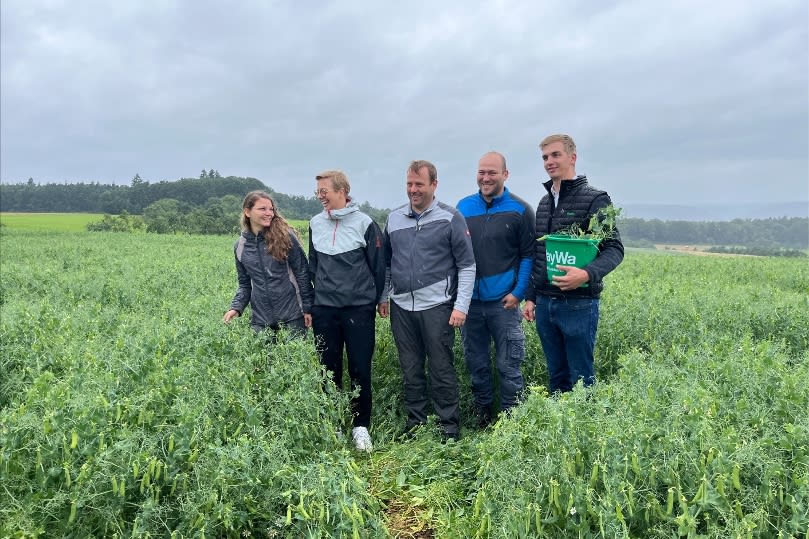Agriculture & nutrition
Cultivating peas and beans

Legumes such as soybeans and chickpeas are the answer to urgent questions: their high protein levels meet the demand of a growing market for vegan and vegetarian foods. And their biological properties make them attractive as intercrops for more climate-resilient agriculture. This is why BayWa is testing new varieties for regional cultivation in a pilot project.
Pilot project: Bean and pea varieties in agriculture
Farmer Philip Vogel is trying out something new in his field: Mung beans. It is one of the first field trials in Germany for the crop, which originates from Asia. A few kilometres away, farmers Jens Mattern and Marius Bischoff are testing the cultivation of new pea varieties from the food tech company Equinom from Israel.


The field trials are taking place as part of a pilot project. The aim is to find out which bean and pea varieties are best suited to regional agriculture and food processing. Peas themselves are not new. Feed peas have been around in Germany for a long time. What is new is the increasing diversity of crop varieties for human consumption, focussing on a higher protein yield.
Their high protein content makes legumes a good basis for many foods. Companies such as Greenforce get the protein from peas and use it in their products. These are mostly meat substitutes, but pea proteins are also popular in egg or milk alternatives.
Market situation: Is it viable to grow peas for agriculture and the food industry?
Both the demand for and variety of products made from alternative protein sources is increasing. Companies produced 16.6% more of these products in 2023 than in the previous year ( Statistisches Bundesamt, as of May 2024). Around ten years ago, at most tofu and the first vegan sausage found their way onto speciality shelves. Today, you can even find chickpea-based tofu or tempeh made from black beans in the supermarket.
But it's not just flavour that counts for consumers. They also value regionality. Companies such as Greenforce, which mainly rely on pea protein for their products, would therefore like to make greater use of peas from regional cultivation.
Die BayWa als Bindeglied zwischen Landwirtschaft und Verarbeitung
In order to meet the growing demand for alternative proteins from regional cultivation, not only the cultivation quantities, but also the processing and trading structures must be expanded. BayWa is planning along the value chain with its New Protein Solutions business unit:
Phase 1: Customer-orientated pre-selection.
The experts at New Protein Solutions are looking for crops that are best suited for regional cultivation and further processing into meat-free foods. First, they test the selected varieties on a small area at the BayWa trial site in Gründl to find out, for example, how the varieties develop under regional weather conditions, what protein content they achieve and how they perform in subsequent processing into food.
Phase 2: Contract cultivation and field trials.
The selected crops go into contract farming. Farmers make a few hectares of their land available for the field trial. They receive technical support from BayWa when cultivating the peas.
Phase 3: Quality testing.
After harvesting and brief storage in the BayWa silos, New Protein Solutions and its processing partners check the quality of the peas. The peas are then transported directly to the processing plant via a short transport route.
Phase 4: Processing.
First, traditional milling technology is used. The peas are shelled, ground and sieved. The concentration of pea protein is then increased and further processed in an extrusion process. The result is a texturate, which serves as the basic raw material for the respective food recipes.
Die Erbse als Chance für eine klimaresiliente Landwirtschaft
Beans and peas belong to the group of legumes. In addition to their protein content, they have another valuable property. And this lies beneath the soil at the roots: the so-called nodule bacteria can bind nitrogen.
Less nitrogen fertiliser when growing peas
Nitrogen is one of the most important soil nutrients. Plants need it to grow and reproduce. Farmers usually add nitrogen in the form of fertiliser. Although nitrogen is available in the air, plants cannot absorb it directly. It must first be converted.
This is precisely the task of the nodule bacteria. They contain an enzyme that binds the nitrogen and converts it into ammonium and ammonia. In other words, nodule bacteria convert the nitrogen into a plant-available form.
Nitrogen that the plant does not need is left in the soil, thus improving soil fertility. In the soil, it is then available as fertiliser for the next crop that the farmer grows. This makes legumes a practical intercrop in the farmer's crop rotation.
Climate resilience: Which varieties can withstand extreme weather?
Drought and heat, heavy rain and flooding – agriculture has to adapt to more frequent extreme weather conditions. The soil is an important factor in this, for example by building up humus. Depending on the type of soil, humus can store three to five times its own weight in water ("Lehrbuch der Bodenkunde", Scheffbuch/Schachtschabel).
Another factor is the choice of crops themselves. Which plants are better able to withstand extreme weather such as heat and drought? Legumes score highly here too. The trick is to find varieties that are climate-resilient as well as profitable to market. A look at the examples from the pilot project shows this:
The Equinom pea
The Equinom pea is a pea variety from the Israeli breeder of the same name. It has been naturally bred to have a particularly high protein content. This is important for food production because: The higher the protein content, the lower the processing effort and the higher the number of vegan foods that result.
The Equinom pea tested in the pilot project has a protein content of a good 30%. By comparison, classic feed peas, such as the Astronaute variety, have a protein content of 22 to 25 %. However, there is no difference in cultivation between Equinom and feed peas.
Good pest management is important in pea cultivation. Without this, it is susceptible to the pea moth. The moth lays eggs on the plant at the time of blooming. As soon as the larvae hatch, they feed on the peas in the pod. This can be prevented with appropriate plant protection measures or a modified crop rotation.
The mung bean
Mung beans come from Asia. They are mainly grown in India. It is a very thermophilic crop. This means that it also copes well with higher temperatures and prolonged drought.
However, this is not the only reason why the experts at New Protein Solutions chose it for a field trial. The mung bean also has food technology advantages that make it attractive for the German market:
- The balanced amino acid profile and the
- good gel-forming ability are good for further processing into vegan foods.
- In addition, the mung bean has a low intrinsic flavour and can therefore be used in many different ways in food production.
The professionals have not yet decided on a specific variety. Together with the Franconian farmer Philipp Vogel, they are first testing on one hectare whether the mung bean will grow well in Germany. If this is the case, the second step is to test different varieties for their properties, for example their protein content or their performance during processing (shelling, grinding, etc.).







